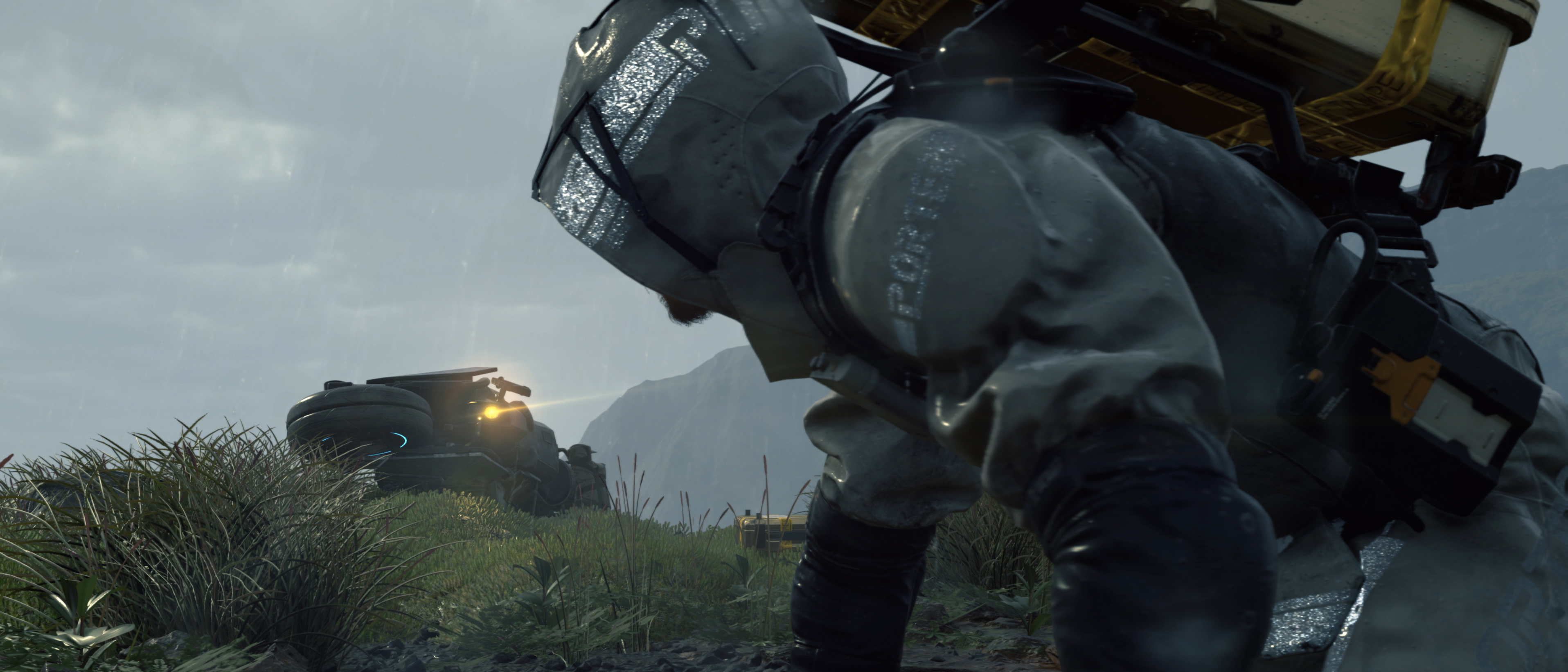TechRadar Verdict
Death Stranding is a wonderfully ambitious sci-fi adventure that combines affecting performances with a compellingly original narrative structure. Its seemingly monotonous premise proves to only further catapult it from ordinary to extraordinary, and its singular sense of self marks it as a distinctly unique and memorable game.
Pros
- +
Dazzling visuals
- +
Real emotional momentum
- +
Complex but intuitive mechanics
- +
Captivating acting performances
- +
Unique narrative
Cons
- -
Combat starts out sluggish
Why you can trust TechRadar
Death Stranding: Director’s Cut – new, improved and an excellent PS5 update
Platform: PlayStation 4 / PlayStation 5
Time played: 42 hours
Just shy of its second birthday, Hideo Kojima’s baby-in-a-jar sci-fi FedEx adventure has received a truly wonderful expanded release for PS5. Death Stranding: Director’s Cut is not only the best way to play this unique and beguiling adventure, but it acts as the blueprint by which all future PS5 re-releases should be judged.
Death Stranding was already a gorgeous game, with a lovingly-digitised version of its cast, including Norman Reedus and Mads Mikkelsen. But the PS5 version looks better still, taking full advantage of the added horsepower under the hood.
“Performance” and “Quality” modes are both present. Both target 60fps, and while the Performance mode is locked in at that framerate, the Quality mode (which has a higher resolution) hovers very close to that consistent 60fps holy grail itself, to the point where I tended to stick with that option. Performance renders at 1800p upscaled to 2160p, with Quality raising to 2160p natively. The frame rate dips at the higher resolution were negligible enough to be easily ignored – the sort of thing that would be eliminated should Sony ever consider adding variable refresh rate (VRR) support for PS5.
There’s also an “Ultrawide” option. As discussed previously on TechRadar, that doesn’t mean you can hook Death Stranding: Director’s Cut up to an ultrawide monitor and enjoy a native 21:9 experience. Instead, it adds cinematic letterboxing to your TV display, resulting in something like a 3840x1640 resolution, if you discount the black bars. It won’t be to everyone’s taste, but the wider field of view does in my opinion add to the awe of the game’s eerie, barren environments. And at the very least, the slightly lower resolution requirements keep the Quality mode option locked at 60fps.
Aside from the resolution and frame rate bump, little has changed in Death Stranding: Director's Cut in terms of visuals. There may be a slightly improved draw distance, but that’s about it. A more transformative addition is that of the full suite of DualSense tactile feedback. You’ll feel the ground under player character Sam Bridge’s feet change as the terrain does through subtle rumbles, and the pitter-patter of rain against your palms. There’s even now keyboard and mouse support, adding further to the accessibility range of the game.
While I didn’t have a PS4 save to transfer to this version of the game, the experience appears to be the one downside to the remaster. Exporting and uploading a save can only be done at an in-game terminal on the PS4 version, and it can’t be done unless you have a clear mission log. Those with leftover tasks will have to delay jumping over to the PS5 version. It’s a clunky system.
On top of all the good stuff though, PS4 players looking to upgrade can do so at a fair price. It’s just £5 / $10 to go from the PS4 version of Death Stranding to the PS5 Director’s Cut, meaning you don’t have to splash out full price for a new version of a game you already have. Keeping in mind there are plenty of new DLC-sized elements that have been added to the core experience, from quality-of-life tools to a “firing range” (a name which does not do justice to the depth of that particular addition) to a madcap racing mode, and it’s a very generous package that we can’t recommend enough.
Death Stranding: Director's Cut PS5 edition analysis by Gerald Lynch.
Scroll down for Cian Maher’s original review of the full game and initial Death Stranding PS4 release, first published in November 2019.
Death Stranding review
After years now of chatter, trailers, confused press junkets, celebrity cameos, and general speculating on what Death Stranding would actually end up being, we've finally got to play the game and piece our thoughts together. The AAA game from Hideo Kojima (Metal Gear Solid series) has built up a lot of hype, and confounded expectation of what a mass market game should look like – and although we’ve played through the story, we've purposely omitted the majority of narrative details from this review to keep it as spoiler-free as possible. Suffice to say, we think it was worth the wait since its 2016 announcement.
The English poet Percy Bysshe Shelley once discussed the humanless majesty of Mont Blanc, describing the mountains as “peopled by the storms alone” – a place untainted by human contact, snows unspoiled by our vainglorious footprint. These ideas are so inherent to Death Stranding’s meditative nature that they breed a quiet melancholy, an inquisitive pondering on the now that would seem impossibly mindful in another context.
- Also check out our Call of Duty: Modern Warfare review
- Here's our Nintendo Ring Fit Adventure review
- Read our Borderlands 3 review
Bridging the fissure
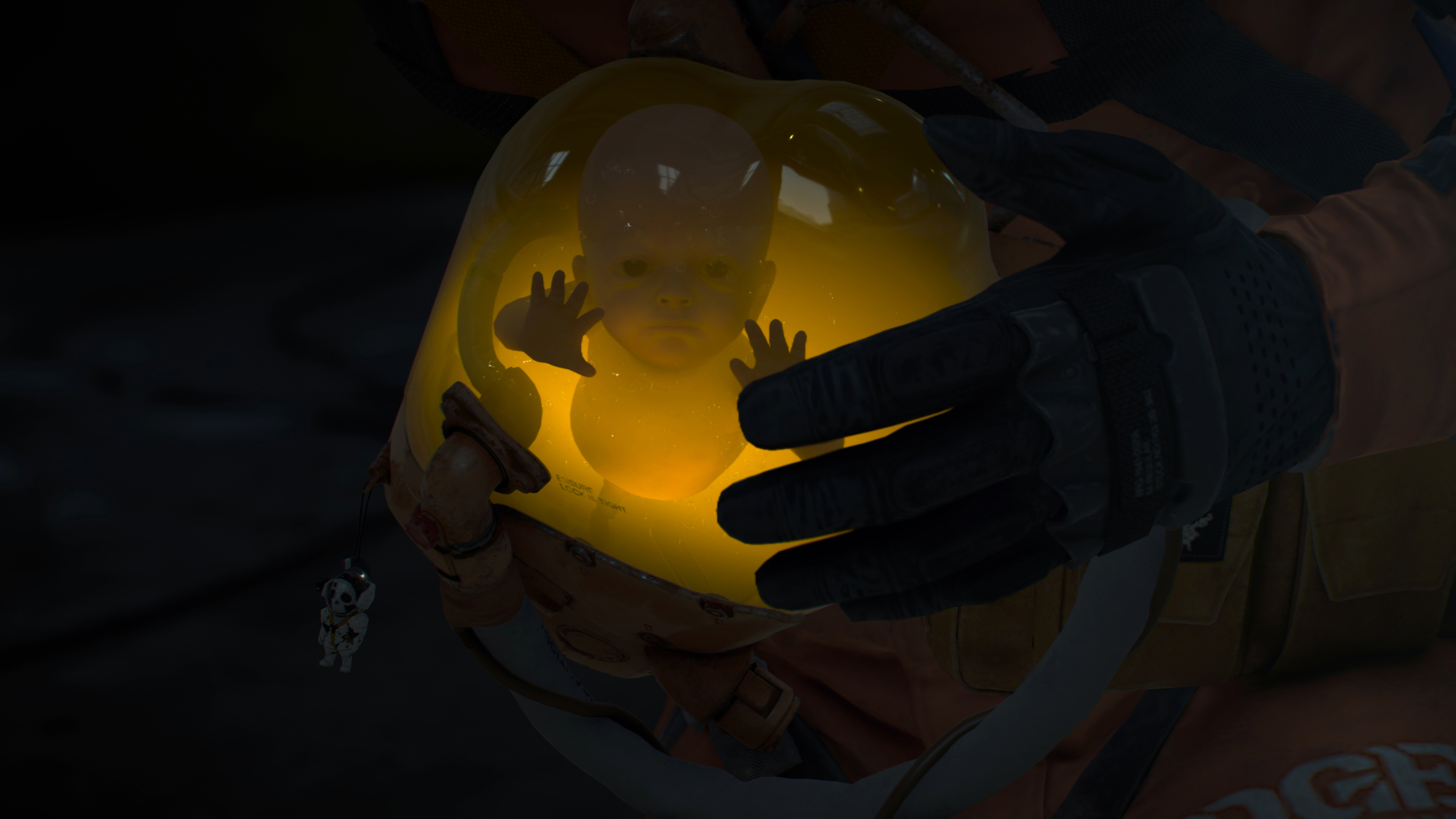
The force that conjures this alluring sense of melancholy is rooted in the pervasive loneliness tied to deliveryman Sam Porter Bridges, a self-imposed outcast with no ties to the world – or anyone.
Bridges inhabits an America that is left fractured, courtesy of the mysterious phenomenon known as the Death Stranding that led to complete societal dissolution. From the ashes, well-meaning institutions attempt to reconnect the country by expanding a curious communication system called the chiral network, where porters deliver cargo to remote waystations in exchange for recruiting them as members of the newly-established UCA (United Cities of America).
However, as the network begins to bridge the gaps formed in the wake of the Death Stranding, the increase in the strange material known as 'chiralium' causes weird environmental phenomena to plague the world. This leads to an upsurge in alien BT activity, an increase in rogue splinter factioneers known as MULEs, and the motives of those with seemingly benevolent intentions blur into a bubbling grey area, as terrorist Homo Demens begin to expose the inner monsters in each and every one of us.
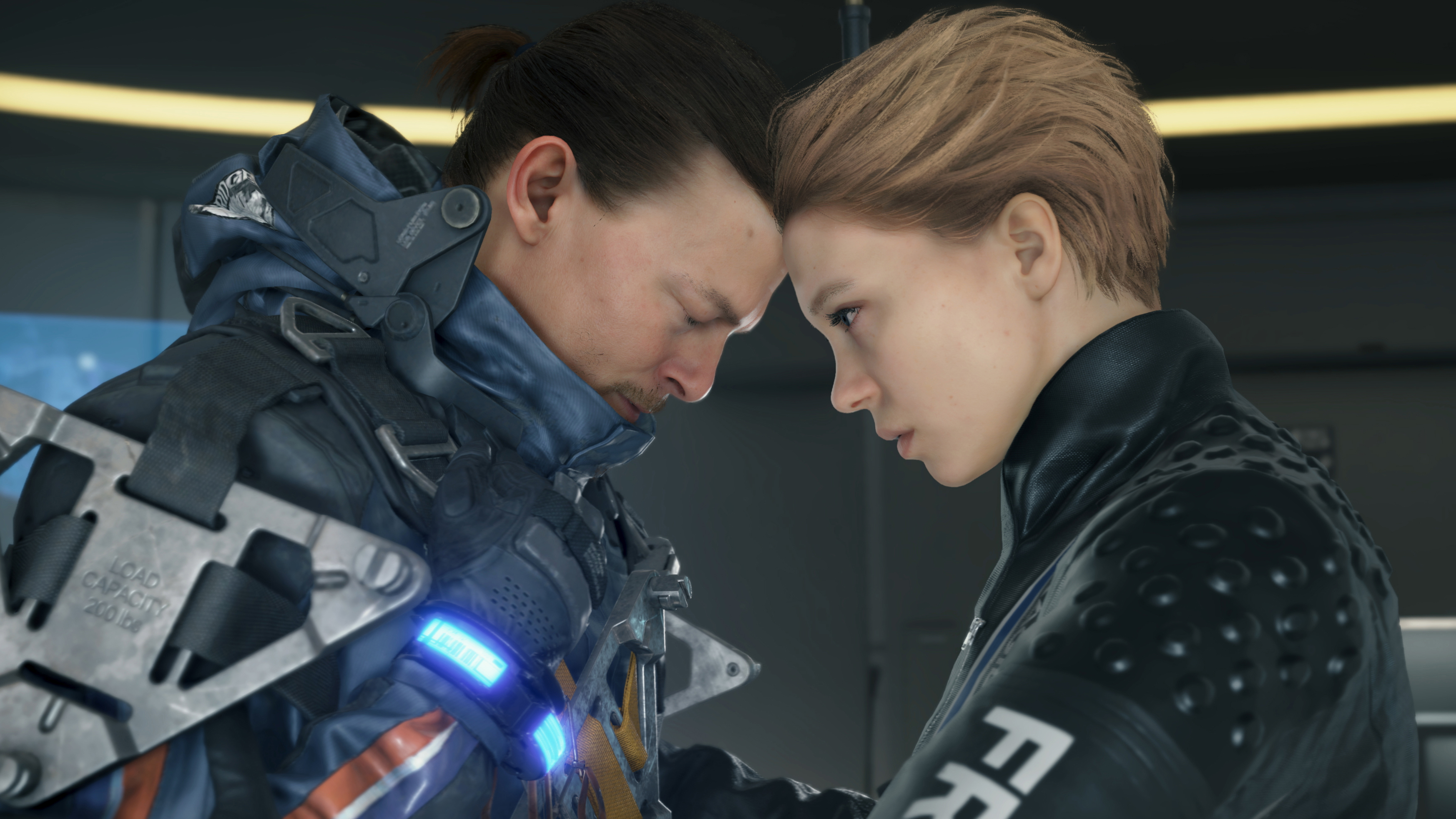
The first few hours of the game are quite confusing, with each revelation fostering a variety of new ambiguities. Mechanically, the beginning mostly asks you to traverse harsh terrain while keeping delicate cargo intact. As you cross impassable abysses and sinuous rivers, the involuntary descent into loneliness is juxtaposed with a solemnity that is, despite itself, quite warm.
You begin to ruminate, even meditate, on the here and now, and the world around you blurs, soft hues blanketing harsh surfaces. The story is, at least at the beginning, superseded entirely by emotional presence, and although the trajectory becomes increasingly linear as you progress toward the endgame, the beginning is wide open, littered with side quests and hidden secrets ripe for discovering in a second playthrough.
The magical thing about this is that it beautifully sums up what’s at the thematic core of Death Stranding: the overt bleakness of this decadent world ultimately begets the truth that sincere hopelessness is an impossible feat. Hope is a human inevitability, an inexorable product of existing against the will of fate. And so this dystopian travesty that has gluttonously swallowed up countless innocents is at all times present, but as a reason to persevere more so than a cause to give in. It’s the single justification for trudging on through the tragically impossible, and wrenching it into a state more compatible with restoration.
Beauty and travesty
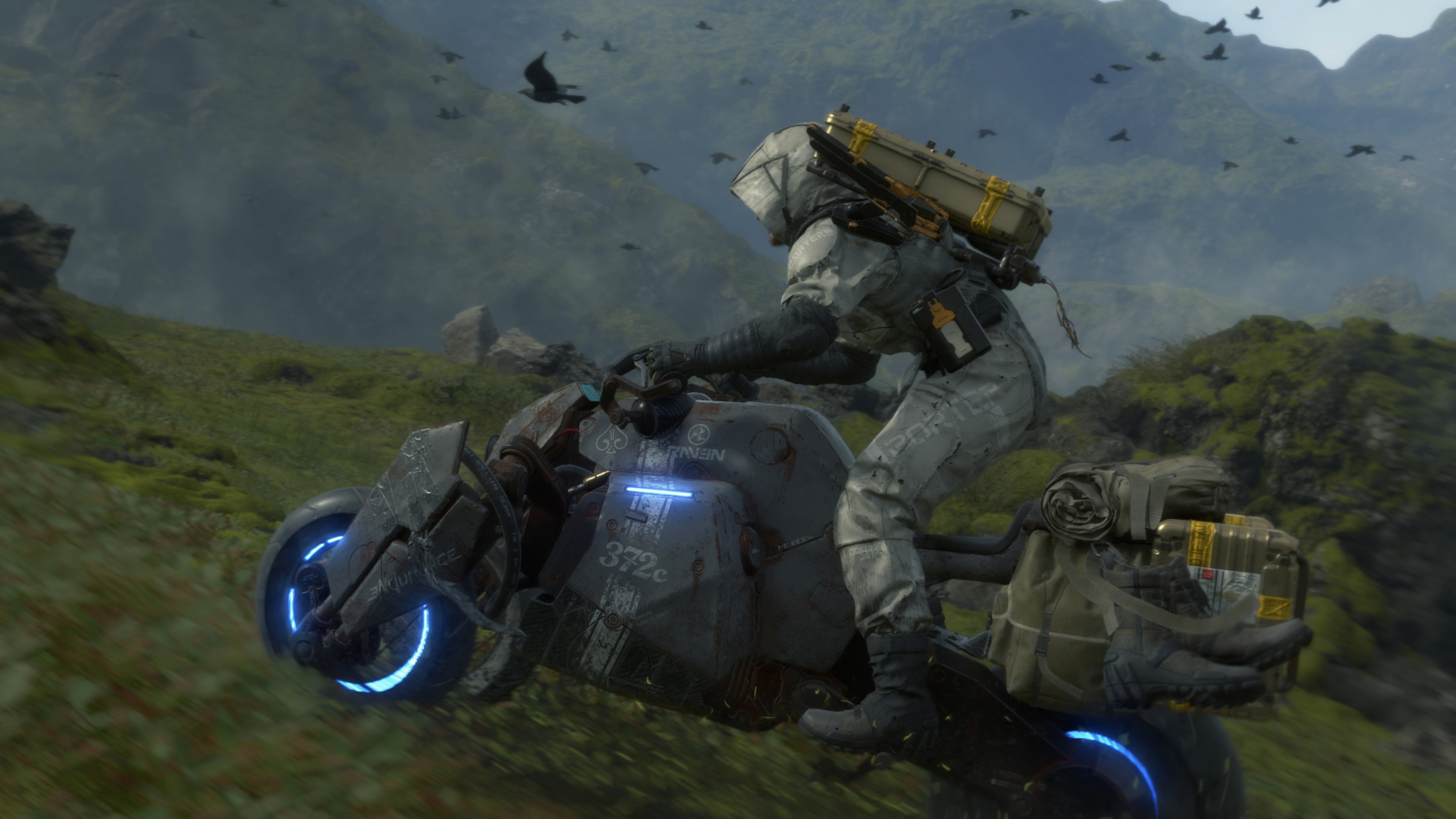
The entire Death Stranding experience is deeply cinematic. Characters are introduced as they would be in a film, and even moment-to-moment play is framed as though each individual angle has been emphatically directed.
It’s easy to haphazardly assign a major release a “gorgeous visuals” tag, but Death Stranding truly earns it – not because of realism, or frame rate, or any technical jargon, but because of how unflinchingly unique it is both stylistically and tonally. This, much like Metal Gear games in the past, has the potential to adjust the way in which games are presented. It’s an evolution of aesthetic, a maturation in form, harrowingly gorgeous and alluringly atrocious.
Take, for instance, an early scene in which a bird is violently wrenched into the obstinate clutches of death: it is struck by Timefall, a curious form of precipitation that causes everything it comes into contact with to rapidly age.
Death Stranding’s environmental critique is courageously unsubtle, with nature itself being far more cruel a mistress than any kind of enemies. In fact, you can eschew violence for stealth in any given scenario — the rain is your most treacherous enemy, alongside the anomalous creatures known as BTs it attracts.
Lay down your weapons
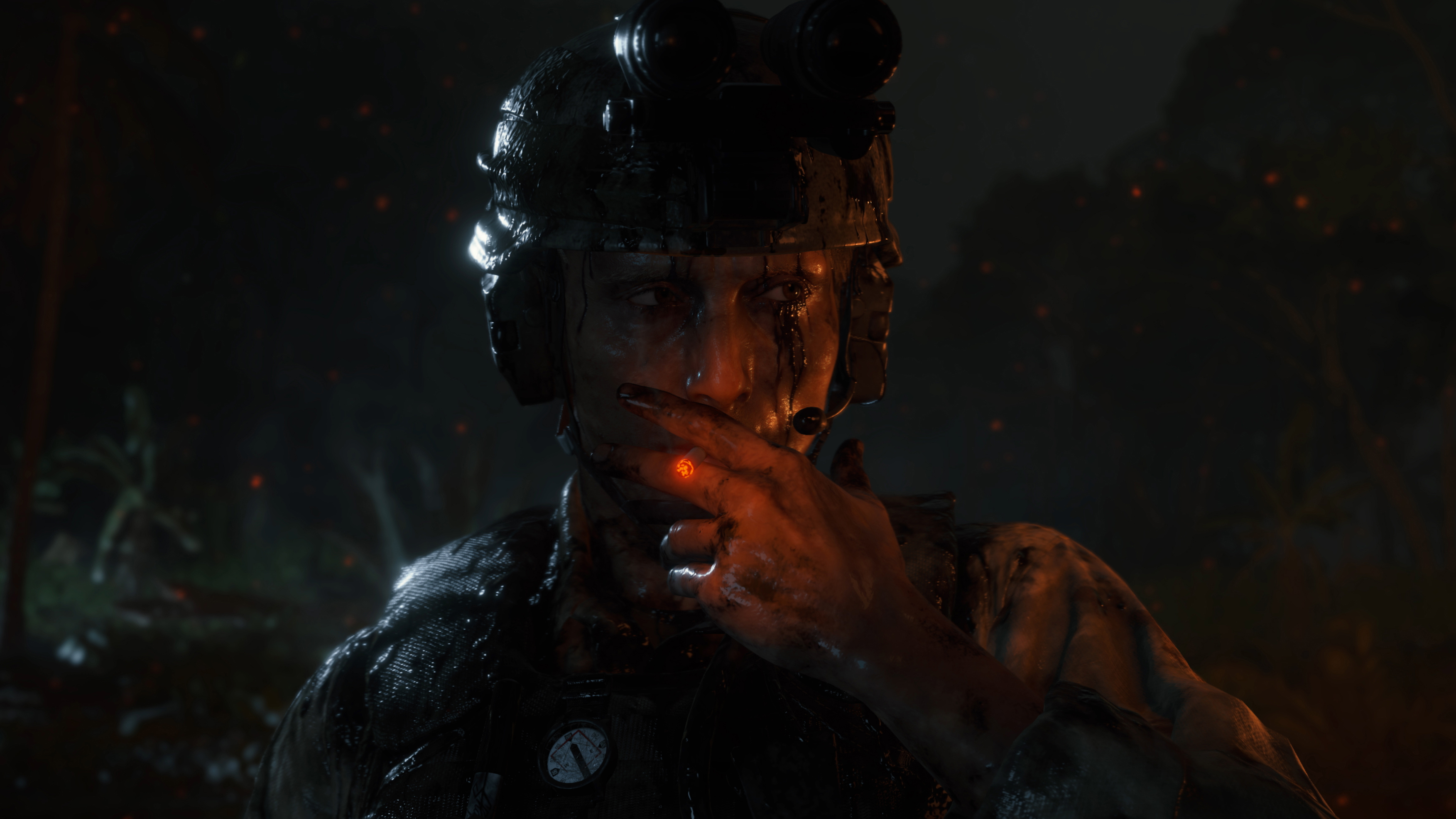
Combat with BTs is far more interesting than combat with humans, which is remarkably unfun when compared to stealth routes. With BTs, however, it becomes very enticing about midway through the game. Before then, your only real way of affecting them is to hurl grenades of your own blood at them, or use a weak gun that infuses droplets of your blood with regular bullets.
These are quite sluggish encounters for the most part, but when a new feature is developed for your cufflinks - the handcuffs that allow you to bring up the main menu and access information about cargo, quests, the world map, and mail - you can stealthily approach BTs and snip the umbilical cords grounding them in reality.
BTs, however, are invisible. The only way to sense them is to rely on your BB, the baby confined to the pod plugged into your suit. This BB, or bridge baby - a bridge between the living and the dead, as Guillermo Del Toro’s Deadman puts it - powers a fan-like mechanism attached to your shoulder, which begins to whir ferociously as you approach a BT.
By holding your breath and inching forward with caution, you’ll be able to advance without startling it, and have the option to cut the cord, sending it on a one-way trip to the land of the dead.
Monotony into sublimity
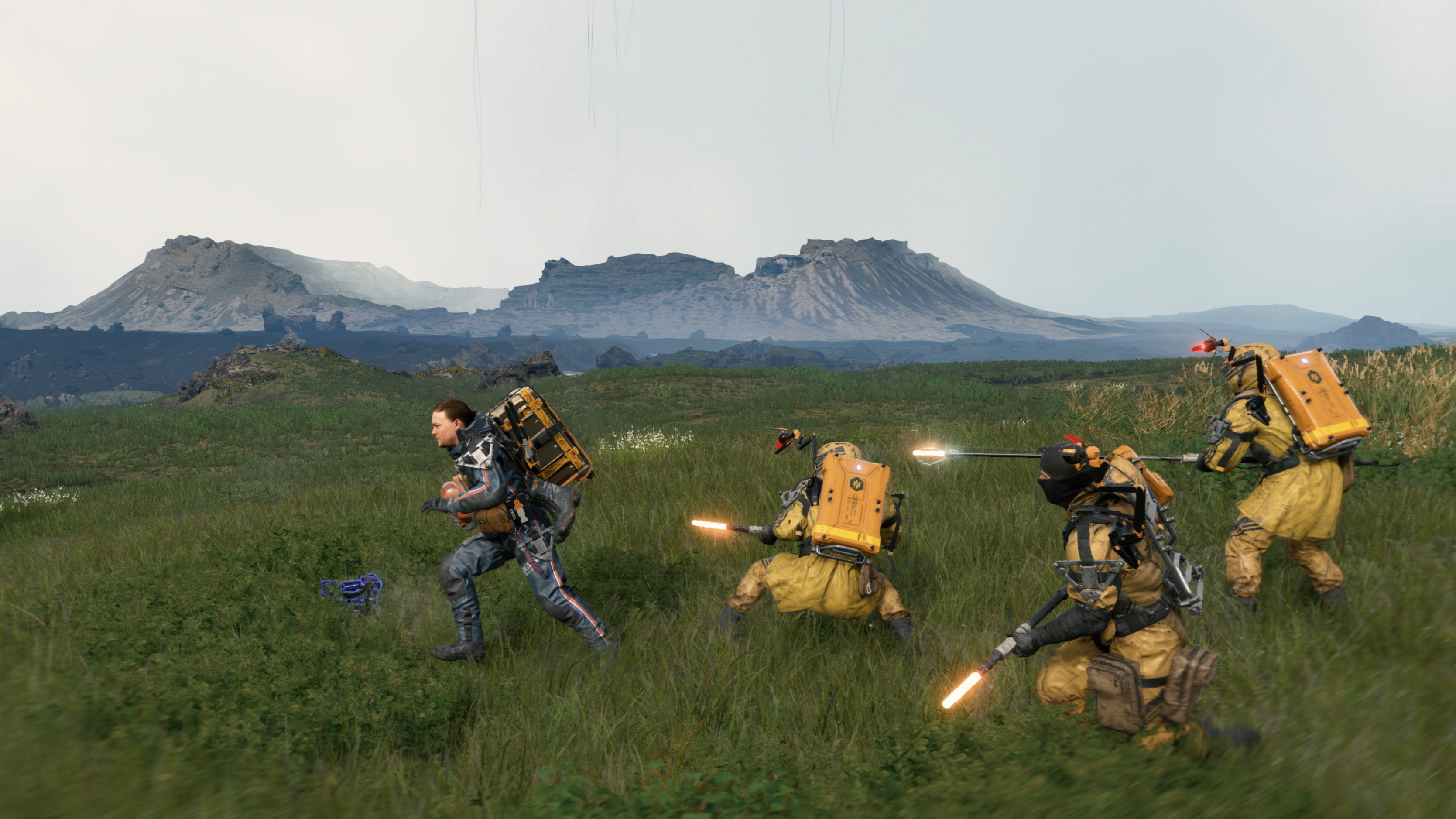
What makes Death Stranding truly special, however, has nothing to do with combat. In the wake of countless imaginings of apocalyptic sunsets, Death Stranding fosters awesome monotony. You are quite literally a delivery man, tasked with transporting cargo from one waystation to another. You have to manage your cargo in a way that balances out — too much weight on your left and you’ll constantly be hammering the right trigger to keep yourself steady, slowing progress and almost indefinitely ending in a nasty fall, damaging your cargo and reducing the amount of likes – a sort of leveling currency afforded to you by other players and NPCs alike – you receive on arrival.
This constant need to balance yourself, to make sure you move steadily onward without hitting the deck, makes all traversal meaningful. You can’t just hold the analog stick forward while you make a cup of coffee. You will, inevitably, fall. This, coupled with the necessary use of the scanner attached to your shoulder, makes studying the terrain in its entirety an essential undertaking prior to an expedition.
As you progress through the game, you gradually gain access to even more planning procedures like weather forecasts, which make plotting routes even more ostensibly monotonous yet weirdly captivating. Before long, you find yourself religiously using the map’s topographical functions - pressing the touchpad and tilting the controller enables you to analyze height and harshness of the terrain - in conjunction with methods of actively avoiding Timefall, remaining outside MULE camps, and avoiding BTs.
This sort of calculated preparation might culminate in what looks like an unnecessarily long trek, but planning for level ground and as few enemy encounters as possible testifies to that old proverb about the tortoise and the hare, and does so in such a way that the former seems all the more appealing.
In terms of mechanical complexity, Death Stranding is meticulously intricate, yet somehow retains fascinatingly functional systems. The UI is stylishly unintrusive despite the amount of information it needs to communicate. New mechanics and features are introduced regularly throughout the whole game – some passively, which is perfectly suited to gradual progression – and yet nothing is ever overbearing, or without merit.
Invisible connections
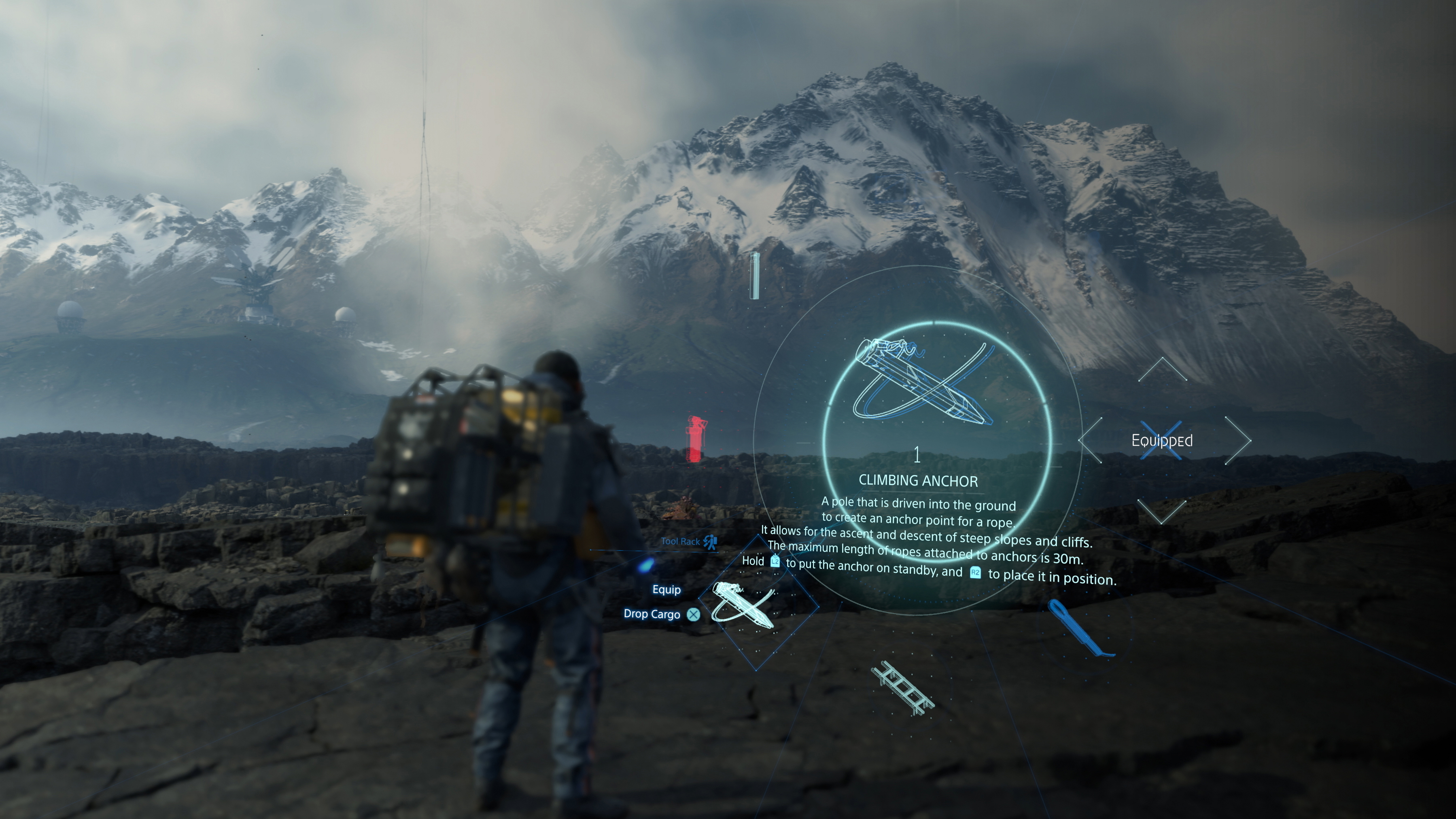
There is a use for each and every item the game provides you with, and the online permanence of structures makes placing them all the more important. For example, a ladder placed in your world will appear in the worlds of other players, and could be the very tool a fellow porter stuck in a rut desperately needs. For this, the fortunate porter in question may reward you with as many likes as they see fit, increasing your rank and inching you ever closer to the prestigious title of ‘The Great Deliverer’.
After you finish Death Stranding, you can continue to set up structures in early areas, invisibly helping newcomers as they set out on their own quest to make America whole again. It’s quite a special thing, as placing structures and leaving either warning or encouraging signs are the only online components available to you. It’s impossible for toxicity to fester in this world, despite how broken and desolate it is. Hope persists.
Death Stranding’s story is, at parts, seemingly convoluted. However, without giving anything away, it ties its conclusive knots with the learned hands of a seasoned sailor - weaving its strands together seamlessly. Almost all of its characters are deeply fascinating, with the exception of one relationship not quite hitting the mark – more because the others are so effortlessly organic than because it’s actually uninteresting.
The characters are all played superbly, with personalities like Norman Reedus, Lea Seydoux, and Guillermo Del Toro stealing the show – Troy Baker is, of course, typically spectacular. The plot points, although sometimes arbitrary at first impression, are inspired and original. The entire narrative is stitched together like a majestic quilt, each individual thread bearing its own equal-weighted significance in the conglomerate whole. It’s an emotional odyssey, where the dull parts only serve to suck you in before the explosive ones detonate.
Verdict
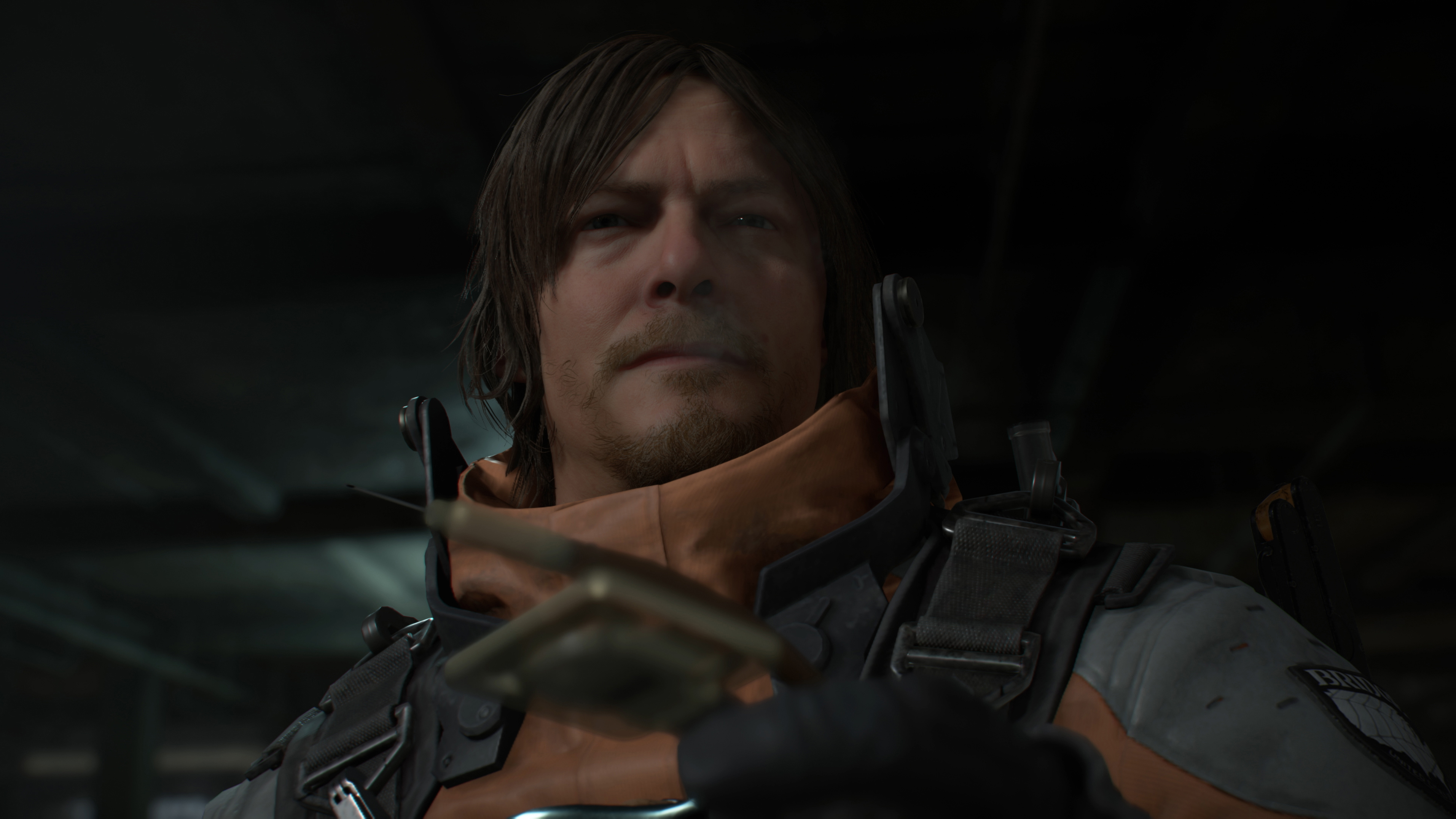
Death Stranding is a game where monotony is innately imbued with intangible subjects of the extraordinary. On paper, the premise shouldn’t work. A deliveryman, a ruined world, a convoluted plot centered around dejection and the abnormal Weird. In execution, however, it’s perfect, unwaveringly confident in itself and assured of its place in the zeitgeist.
It’s a game, an experience, where introspection is derived from futilely confronting the macrocosm of a decaying world. It’s a story where hopelessness is the source and adversary of an unquantifiable, incomprehensible desire to persevere.
Death Stranding is a Sony PS4 exclusive, with a PC port set to arrive mid-2020.
- Best upcoming games 2019: most anticipated titles for PS4, Xbox One and Switch
- Check out our picks of the best PS4 games
Gerald is Editor-in-Chief of iMore.com. Previously he was the Executive Editor for TechRadar, taking care of the site's home cinema, gaming, smart home, entertainment and audio output. He loves gaming, but don't expect him to play with you unless your console is hooked up to a 4K HDR screen and a 7.1 surround system. Before TechRadar, Gerald was Editor of Gizmodo UK. He is also the author of 'Get Technology: Upgrade Your Future', published by Aurum Press.
